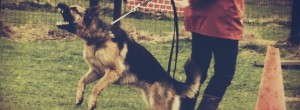Why does my dog bark and lunge at other dogs on leash?
First, rest assured, you are not alone. This behavioral issue is so common that there are volumes of books specifically written about the subject. Dog trainers and behaviorists refer to this issue as “on-leash aggression” or “on-leash reactivity”. That being said, this is a serious issue that needs addressing as soon as possible – the longer you wait, and the more it happens, the harder it is to address. A reactive dog can bite other dogs and even bite dog owners nearby.
What is it?
A dog with on-leash reactivity often gets along marvelously with other dogs when off-leash at the park, or in the yard, or even in home. But the minute you put on a leash and go for a walk, he becomes interested, then agitated at the sight of a dog at a distance. As you get closer, he expresses the frustration by barking, howling, lunging, and even biting. He’s so fired up that calling his name, luring him with food, or even applying leash corrections does nothing.
Photo courtesy of Päivi Reijonen (dog trainer and behaviorist) – view the entire set on Flickr: http://www.flickr.com/photos/30096200@N08/sets/72157623555143141/
What causes it?
Every dog is different, and it is difficult to figure out exactly why a specific dog develops this issue. Here are a few common reasons:
The dog never learned to walk loosely on leash, or focus on the handler when called. As a result, the dog is used to pulling around everywhere to investigate everything. The sight of a dog on the sidewalk is a novel distraction at first, so a puller struggles to go meet and sniff that other dog. Naturally, on-leash, and on the sidewalk, your dog doesn’t have the freedom to wander up and sniff every dog. The frustration of being unable to get to that interesting thing, compounded by the physical pain of the collar tension that occurs when pulling towards another dog is highly unpleasant. Soon, the dog associates the sight of another dog with feelings of frustration and pain, and very soon, through simple classical conditioning, the dog sees other dogs on the street as the reason for that feeling and pain. As it happens each and every time they see a dog on leash, the conditioning occurs very quickly.
The dog had learned to be fearful or dislike other dogs. This can occur if a dog has been harassed or attacked by another dog – sometimes it just takes one bad experience to make a dog fearful. This can also occur if a dog was not exposed to a wide variety of other friendly dogs while it was a puppy. In an off-leash setting, the dog has the option to flee. When a dog is on leash, we’ve taken away that option, so all that’s left is freeze, or fight. The on-leash reactive dog is barking and lunging to send the other dog away proactively.
The dog may be ill or injured. Dogs hide injury well, and perfectly well socialized dogs that suddenly start acting aggressively (in any context) may be hurt and vulnerable, and instinctively become more defensive. Make sure your dog is fully vetted to check for illness or injury.
What does not cause it:
Unfortunately, many “experts” are extremely misinformed about this and most other behavioral issues. Here are the most common and incorrect explanations they provide:
- The dog is “dominant” and wants to fight every other dog.
- Dogs have been selectively bred over many generations to avoid conflict – a species that is genetically predisposed to fighting tends to make itself extinct. Also, if the dog was a natural born fighter, he wouldn’t be an angel at the off leash dog park.
- The dog doesn’t respect you as the “leader” or “alpha” or whatever and therefore is protecting you.
- There is a behavioral issue called “resource guarding” where dogs guard their owners, but it is far more rare and typically occurs on or off-leash.
- On-leash reactive dogs can be extremely well trained in obedience, and do everything their handler asks, and still lunge and bark.
- You are not calm and assertive.
- You could be totally oblivious to the fact there’s a dog approaching (and therefore relaxed) and the leash-reactive dog would still bark and lunge if they see the other dog first.
What training techniques should we avoid?
If you are advised to do any of the following, run far, far away from that trainer:
- Leash corrections
- The dog already fears and dislikes other dogs. Causing additional pain and discomfort whenever he sees another dog only compounds the feelings of frustration, fear, and hatred. The correction may suppress the behaviour but the emotional attitude the dog has continues to slide into deeper frustration and hatred of dogs on leash. The dog has also not learned any desirable behaviour in its place (such as look at the handler).
- Spray bottles or citronella collars
- Many dogs fear spray bottles or citronella collars, so these “softer” aversives should not be used for the same reason. Conversely, many dogs do not care about getting water in the face, rendering them useless. In both cases, the dog has learned nothing.
- Physical violence (yelling, hitting, poking, tapping, kicking, alpha-rolling, etc.)
- You may suppress the behaviour (probably not) but you have also put yourself at severe risk of being bitten.
- A dog learns that humans are dangerous, and hands are dangerous – you are creating a fear-biting dog.
What should you do about it?
Any behaviour issue that puts dogs and people at risk of injury is serious and is not something you should address on your own. This work requires you to have both knowledge of classical conditioning, operant conditioning, and practical work to manage your dog and deliver food rewards all while walking your dog on leash. Get the help of a professional dog trainer or behaviourist that prescribes the following:
- Manage the environment – do not allow your dog to rehearse the barking and lunging. This means maintaining distance from other dogs while on leash as you train.
- Change the dog’s emotional attitude towards other dogs while on leash – This is best accomplished by feeding your dog high value food (cheese, hot dogs, steak, chicken) each and every time he sees a dog while on leash.
- Focus on safety – a head halter, or in extreme cases, a basket muzzle, ensures that you, your dog, and other owners and dogs are safe while you do the work.
- Train an incompatible behavior – If you train the dog to look at your face and lock on when a dog approaches, it now has something to do other than bark and lunge.
Compare and Contrast: Good Training vs Bad Training
The first video is from Instinct Dog Training – using a combination of operant conditioning and classical conditioning to teach a leash-reactive dog to tolerate and then eventually like other dogs. You know the dogs are relaxed because of their body language.
The second video from a certain TV program shows the use of severe leash corrections as a punishment to suppress behavior. In this case, the aggressive dog looks at another dog – the person kicks the dog (2:56), triggering the dog to bite, and then proceeds to choke the dog till it nearly suffocates. The person is bitten and dogs subjected to this punishment will suffer neck, spinal, tracheal, and ocular damage. If the owners tried this they would likely require hundreds of stitches.
Behaviour Modification Done Humanely:
https://www.youtube.com/watch?v=Ayl8K5P66ho
Use of Aversive Punishment to Suppress Reactions, Triggering Human-Directed Aggression:
https://www.youtube.com/watch?v=Pw3glB4qQPY
Get Help!
Get on-demand access to our recorded Helping the Leash Reactive Dog webinar here.
Rachael Johnston, KPA CTP, and the developer of When Hounds Fly’s Reactive Dog program, will guide you through what reactivity is, how and why it develops, and how you can begin to help your dog work through their reactivity challenges.
Also, we are proud to offer our Behaviour Modification services to anyone, anywhere in the world via videoconference. Since March 2020 and the Covid-19 Pandemic, we have been seeing clients via videoconference and we’re been able to help people and their dogs regardless of where they’re located. So even if you’re not based in Toronto, Canada, contact us to see if we can help you…
Click here to learn more about our Behaviour Modification services.

